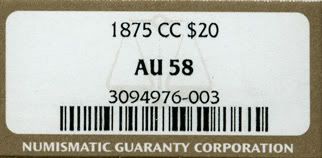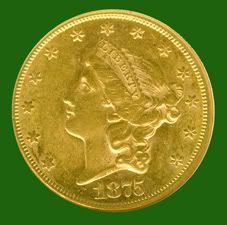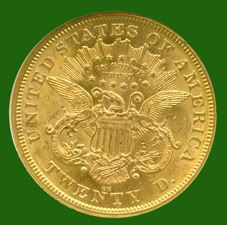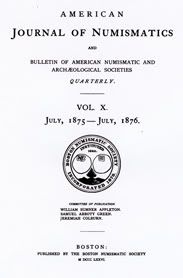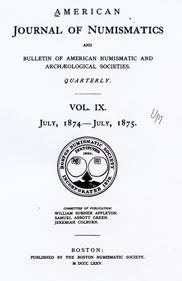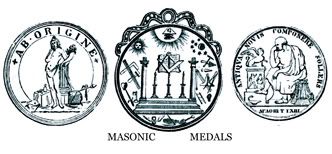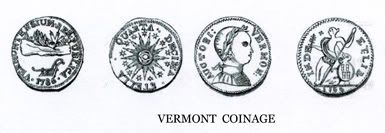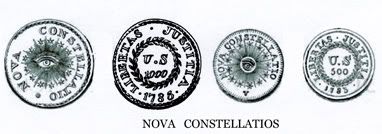- Posts: 177
- Thank you received: 0
1875-CC $20 Carson City Coin of the Week 3-13-2011
14 years 9 months ago - 14 years 9 months ago #2180
by LITAS
Circulation strike mintage: 111,151
The 1875-CC is the most available Carson City double eagle from the 1870's and it is the single most available Type Two issue from this mint. It is easily located in all circulated grades and can be found in the lower Uncirculated grades without much effort. It is scarce in MS-62 and rare in MS-63. Just two examples are known at the MS-64 level.
Finest Smithsonian Institution specimen: AU-53
The level of eye appeal is typically better than any other Carson City double eagle struck prior to 1882. While most 1875-CC double eagles do show numerous abrasions, it is possible to find a reasonably clean piece with good luster and pleasing coloration.
Beware that many higher end coins are being enhanced in an attempt to gain a higher grade from one of the grading services and are being destroyed as a result. At that point these coins can be bought as "Genuine". The estimate of total known pieces of 1875-CC double eagle are between 2,500 - 3,000+, with Mint State pieces from 200 - 500.
PCGS suggested prices are as follows,
XF-30 $1,925
XF-40 $2,300
AU-55 $4,000
MS-60 $6,000
MS-62 $11,500
MS-63 $28,000
MS-64 $75,000
Some coins were sold at the auction,
May 2009, NGC, AU-58, $3,335
October 2008, NGC, MS-63, $20,700
November 2005, PCGS, MS-62, $12,650
January 2004, PCGS, MS-64, $48,875
In 1870 the Carson City Mint opened for business. The early issues of this mint were mostly used in the West, however by 1875 quantities of Carson City double eagles were used in the export trade, shipped to Europe and South America markets via the port of San Francisco. Years later, many of these coins returned to the USA mostly in EF and AU grades with a few MS coins. However, as Carson City double eagles were minted in small numbers, the quantities returned were not extensive.
For example, in October of 1875, commissioner of the Belgian Mint selected 50 coins at random from 37,000 double eagles at hand and assayed them. The average gold content was 900.079/1000 pure gold. The interesting point is that among 50 coins chosen, there were: 1870-CC (one), 1873-CC (one), 1874-CC (one) and 1875-cc (one). The 1870-CC double eagle must not have been a rare coin at that time.
It was interesting to look at the "American Journal of Numismatics" for the year of 1875. This journal came out quaterly and contained a lot of information about foreign and US coins and medals.
In 1875 images of coins were difficult to obtain, so numismatists used drawings and rubbings of coins to communicate.
In the 267 pages Carson City Mint was not mentioned once and Nevada only twice.
The San Francisco Mint was mentioned a number of times. For example, "the principle die (not press ???)in the new San Francisco Mint weighs almost fifteen tons, and is largest ever made in the United States. It will be used for coining twenty-dollar pieces and the trade dollars".
The 1875 20 cent coin is described in minute detail. "It was intended for circulation in the Pacific coast States, where the need of such a coin has long been felt in making change". A few pages later there is a statement as follows, "The fact that our small nickel and copper coinage is very scarce in California, was recently explained by a statement that large quantities of three and five-cent pieces are annually melted down for the purpose of manufacturing trunk nails." Trunks for what? Trunks for shipping coins to China?
In 1875, according to Dr. Linderman, director of the United States Mint, fine silver was worth about $1.25 per ounce and gold was at $16.00 per ounce. This makes a ratio of gold to silver of 12.8, present day ratio is around 40. With gold selling around $1,400 per ounce, if we were to reach the ratio of 1875, the silver now would be selling above $100 per ounce.
It is interesting to read about what the numismatists of 1875 were collecting,
Lists of coins for sale, have a lot of Early Colonial coins, medals, patterns. A few $10 and $5 gold pieces and only two offerings of $20 gold pieces. In 1875 $20 was a very large sum and only very rich could afford to collect them. With gold at $16 per ounce the $20 gold pieces were offered at $21, $10 gold pieces at $17 and $5 gold pieces at $14 each.
There were pages of discussion about the origin of the dollar symbol ($).
At the end of most pages there was a column called "Currency", comprised of witty sayings.
Gold is either a tyrant or a slave.
The "golden age" is certainly not the present one.
Good bones are better than gold.
Many a man is rich without money.
One bad thing about gold --- Not having it.
Where to go when short of money --- go to work.
How to make money go far --- Give it to foreign missions.
The species most wanted to settle the country's financial matters -- Gold and Silver.
At the same time back in Nevada, Virginia City had a population of more than 25,000 people. It was able to support 110 saloons, 50 dry goods stores, 20 laundries, four banks, six churches, public and private schools and an active rairoad. Average mainer's pay was $5 per day (only $1 per day in Europe), however housing was $20 per week. Prices were high.
A great fire in October of 1875 destroyed nearly three quarters of the Virginia City. Soon it was rebuilt.
At the Carson City Mint, a second small press was purchased by Craford and installed. The coin production was incresed in 1875. The mint soon became overworked. However, a recommendation that the facility be enlarged was shot down due to a lack of funds.
In 2011, double eagles produced by Carson City Mint in 1875 are a pretty good value. One gets nearly an ounce of gold with some real numismatic value. For example, while common double eagles in XF sell for $1,800 -$1,850 per coin, 1875-CC double eagles in XF sell for $1,900-$2,300. For a couple hundred dollars more one can get a double eagle with two little "CC" on the reverse.
John Armonas
1875-CC $20 Carson City Coin of the Week 3-13-2011 was created by LITAS
Circulation strike mintage: 111,151
The 1875-CC is the most available Carson City double eagle from the 1870's and it is the single most available Type Two issue from this mint. It is easily located in all circulated grades and can be found in the lower Uncirculated grades without much effort. It is scarce in MS-62 and rare in MS-63. Just two examples are known at the MS-64 level.
Finest Smithsonian Institution specimen: AU-53
The level of eye appeal is typically better than any other Carson City double eagle struck prior to 1882. While most 1875-CC double eagles do show numerous abrasions, it is possible to find a reasonably clean piece with good luster and pleasing coloration.
Beware that many higher end coins are being enhanced in an attempt to gain a higher grade from one of the grading services and are being destroyed as a result. At that point these coins can be bought as "Genuine". The estimate of total known pieces of 1875-CC double eagle are between 2,500 - 3,000+, with Mint State pieces from 200 - 500.
PCGS suggested prices are as follows,
XF-30 $1,925
XF-40 $2,300
AU-55 $4,000
MS-60 $6,000
MS-62 $11,500
MS-63 $28,000
MS-64 $75,000
Some coins were sold at the auction,
May 2009, NGC, AU-58, $3,335
October 2008, NGC, MS-63, $20,700
November 2005, PCGS, MS-62, $12,650
January 2004, PCGS, MS-64, $48,875
In 1870 the Carson City Mint opened for business. The early issues of this mint were mostly used in the West, however by 1875 quantities of Carson City double eagles were used in the export trade, shipped to Europe and South America markets via the port of San Francisco. Years later, many of these coins returned to the USA mostly in EF and AU grades with a few MS coins. However, as Carson City double eagles were minted in small numbers, the quantities returned were not extensive.
For example, in October of 1875, commissioner of the Belgian Mint selected 50 coins at random from 37,000 double eagles at hand and assayed them. The average gold content was 900.079/1000 pure gold. The interesting point is that among 50 coins chosen, there were: 1870-CC (one), 1873-CC (one), 1874-CC (one) and 1875-cc (one). The 1870-CC double eagle must not have been a rare coin at that time.
It was interesting to look at the "American Journal of Numismatics" for the year of 1875. This journal came out quaterly and contained a lot of information about foreign and US coins and medals.
In 1875 images of coins were difficult to obtain, so numismatists used drawings and rubbings of coins to communicate.
In the 267 pages Carson City Mint was not mentioned once and Nevada only twice.
The San Francisco Mint was mentioned a number of times. For example, "the principle die (not press ???)in the new San Francisco Mint weighs almost fifteen tons, and is largest ever made in the United States. It will be used for coining twenty-dollar pieces and the trade dollars".
The 1875 20 cent coin is described in minute detail. "It was intended for circulation in the Pacific coast States, where the need of such a coin has long been felt in making change". A few pages later there is a statement as follows, "The fact that our small nickel and copper coinage is very scarce in California, was recently explained by a statement that large quantities of three and five-cent pieces are annually melted down for the purpose of manufacturing trunk nails." Trunks for what? Trunks for shipping coins to China?
In 1875, according to Dr. Linderman, director of the United States Mint, fine silver was worth about $1.25 per ounce and gold was at $16.00 per ounce. This makes a ratio of gold to silver of 12.8, present day ratio is around 40. With gold selling around $1,400 per ounce, if we were to reach the ratio of 1875, the silver now would be selling above $100 per ounce.
It is interesting to read about what the numismatists of 1875 were collecting,
Lists of coins for sale, have a lot of Early Colonial coins, medals, patterns. A few $10 and $5 gold pieces and only two offerings of $20 gold pieces. In 1875 $20 was a very large sum and only very rich could afford to collect them. With gold at $16 per ounce the $20 gold pieces were offered at $21, $10 gold pieces at $17 and $5 gold pieces at $14 each.
There were pages of discussion about the origin of the dollar symbol ($).
At the end of most pages there was a column called "Currency", comprised of witty sayings.
Gold is either a tyrant or a slave.
The "golden age" is certainly not the present one.
Good bones are better than gold.
Many a man is rich without money.
One bad thing about gold --- Not having it.
Where to go when short of money --- go to work.
How to make money go far --- Give it to foreign missions.
The species most wanted to settle the country's financial matters -- Gold and Silver.
At the same time back in Nevada, Virginia City had a population of more than 25,000 people. It was able to support 110 saloons, 50 dry goods stores, 20 laundries, four banks, six churches, public and private schools and an active rairoad. Average mainer's pay was $5 per day (only $1 per day in Europe), however housing was $20 per week. Prices were high.
A great fire in October of 1875 destroyed nearly three quarters of the Virginia City. Soon it was rebuilt.
At the Carson City Mint, a second small press was purchased by Craford and installed. The coin production was incresed in 1875. The mint soon became overworked. However, a recommendation that the facility be enlarged was shot down due to a lack of funds.
In 2011, double eagles produced by Carson City Mint in 1875 are a pretty good value. One gets nearly an ounce of gold with some real numismatic value. For example, while common double eagles in XF sell for $1,800 -$1,850 per coin, 1875-CC double eagles in XF sell for $1,900-$2,300. For a couple hundred dollars more one can get a double eagle with two little "CC" on the reverse.
John Armonas
Last edit: 14 years 9 months ago by LITAS.
Please Log in to join the conversation.
- deepsouthspike
-

- Offline
- Senior Member
-

Less
More
- Posts: 91
- Thank you received: 0
14 years 9 months ago #2188
by deepsouthspike
Replied by deepsouthspike on topic Re:1875-CC $20 Carson City Coin of the Week 3-13-2011
John,
"Where to go when short of money --- go to work",(I like that!)
Great coin of the week post!
"In 1875 images of coins were difficult to obtain, so numismatists used drawings and rubbings of coins to communicate"
This is something to think about, (a rubbing of a coin)
It is forums such as the C4OA's and the 111 coin of the week project
that makes you realize just how far collecting and the sharing of our knowledge has come with the images available today!
I enjoyed your post, Thank you!
deepsouthspike.....Tom DeFina
"Where to go when short of money --- go to work",(I like that!)
Great coin of the week post!
"In 1875 images of coins were difficult to obtain, so numismatists used drawings and rubbings of coins to communicate"
This is something to think about, (a rubbing of a coin)
It is forums such as the C4OA's and the 111 coin of the week project
that makes you realize just how far collecting and the sharing of our knowledge has come with the images available today!
I enjoyed your post, Thank you!
deepsouthspike.....Tom DeFina
Please Log in to join the conversation.
14 years 9 months ago #2194
by Belayoff
C4OA Lifer!
Replied by Belayoff on topic Re:1875-CC $20 Carson City Coin of the Week 3-13-2011
John,
An interesting post, with a twist from your research in those old numismatic journals. Just curious, did you get them from the ANA library?
I couldn't help notice that the most recent sale date example was 2009. Almost three dozen 1875-CC Double Eagles have sold at Heritage auctions alone since the first quarter of 2010. Here are just a few of the most recent sales;
FEBRUARY 2011 - LONG BEACH AUCTION
AU-58 - 4,025
MS-62 - 11,500
JANUARY 2011 - FUN - TAMPA
XF-45 - 2,530
AU-53 - 2,760
AU-55 - 2,760
AU-55+ 4,168
The above three AU graded coins would be interesting to compare, due to the range of bidding.
MISC VENUES AUGUST - OCTOBER 2010
MS-63 - 24,150
MS-62 - 10,350
MS-62 - 10,637
There were are few others sold in December of 2010 as well, though several were "details only" graded.
Belay Off
An interesting post, with a twist from your research in those old numismatic journals. Just curious, did you get them from the ANA library?
I couldn't help notice that the most recent sale date example was 2009. Almost three dozen 1875-CC Double Eagles have sold at Heritage auctions alone since the first quarter of 2010. Here are just a few of the most recent sales;
FEBRUARY 2011 - LONG BEACH AUCTION
AU-58 - 4,025
MS-62 - 11,500
JANUARY 2011 - FUN - TAMPA
XF-45 - 2,530
AU-53 - 2,760
AU-55 - 2,760
AU-55+ 4,168
The above three AU graded coins would be interesting to compare, due to the range of bidding.
MISC VENUES AUGUST - OCTOBER 2010
MS-63 - 24,150
MS-62 - 10,350
MS-62 - 10,637
There were are few others sold in December of 2010 as well, though several were "details only" graded.
Belay Off
C4OA Lifer!
Please Log in to join the conversation.
- Loosechange
- Offline
- Platinum Member
-

- Married to my best friend!
Less
More
- Posts: 504
- Thank you received: 0
14 years 9 months ago #2230
by Loosechange
Go "CC'S"
Replied by Loosechange on topic Re:1875-CC $20 Carson City Coin of the Week 3-13-2011
Nice coin John, I looks like a lot higher grade than a AU-58. I have seen MS-60's not as nice as yours. Great post.
Loosechange
Loosechange
Go "CC'S"
Please Log in to join the conversation.
Time to create page: 0.122 seconds



